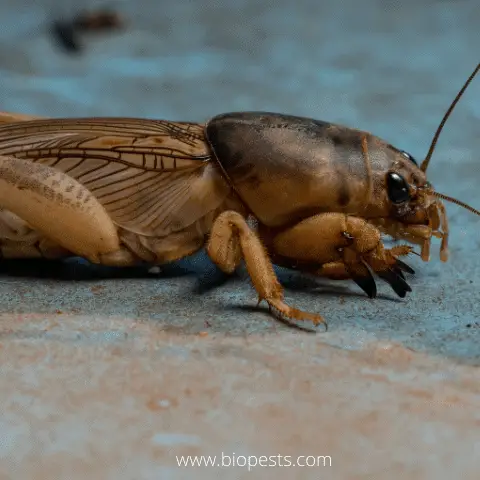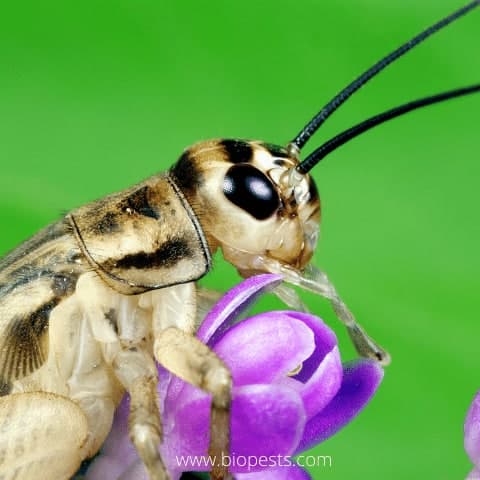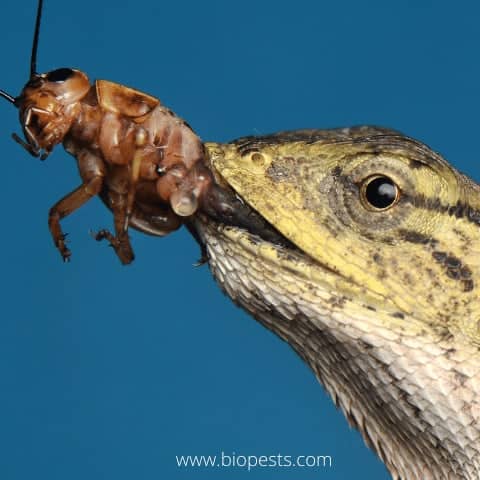If the mention of the word crickets brings a feeling of dread to you, you are not alone! For many people, crickets are pests as they are loud and noisy, especially if they manage to get into your house at night. To others, crickets are an annoying garden pest that eats their well looked after plants.
Crickets can be either harmful and destructive or beneficial to your garden. They are deemed good insects because they feed on other destructive bugs in your garden, controlling their numbers, but they will eat young plants and shoots, making crickets occasionally bad for your garden plants.
Most garden crickets are nocturnal and spend most of the day underground, only coming out at night to feed. They can control harmful bugs in your garden, so before you eliminate crickets, decide whether they are protecting or damaging your plants and whether they are good or bad insects to have in your garden.
Why Are There So Many Crickets In My Garden?
Like all living creatures, crickets will move into your garden in search of food, water, warmth, and shelter from the elements. They are scavengers and will move into any area which will supply their needs. They are not fussy eaters and will eat anything that looks good to them.
They generally migrate into your garden towards the end of summer once the plants and weeds start to die off. If you have crickets living in your garden, it means that you have ideal conditions for them to survive and thrive! They will stay in your garden until the food runs out or until you move them.
Crickets are detritivores which means that they eat the leaf litter on your garden floor. Any piles of leaves, garden debris, decaying plant material, and even fungi will attract crickets to your garden. Garbage cans and compost heaps offer tasty treats for crickets!
Crickets are also omnivores, which means they will eat small insects, eggs, pupae, scale, and aphids. However, they will happily feed on any plant material, pollen, and nectar available to them.
Crickets can be beneficial to your garden as after they have finished eating, they produce fecal pellets that are easily decomposed back into the soil. Cricket manure is often referred to as “gardeners gold” as it contains many nutrients, improves soil health, and is commercially sold to the public!
Crickets are closely related to grasshoppers and are often incorrectly identified. It’s essential to correctly identify each insect because if they become a problem, you will have to control their population or get rid of them.
Two types of crickets will live in your garden if the conditions are right:
Field Crickets
The field cricket is a black or brown shiny cricket with large hind legs used for jumping. They do have wings, but not all field crickets can fly.
The field cricket is found in fields and lawns, forests, caves, and even damp basements. They are highly tolerant to many environments and live in shallow burrows or dead or living vegetation above the soil. This cricket feeds at night and needs to eat its body weight or more in food each day.
While the field cricket is an omnivore, it also eats a significant number of weeds. They can become destructive pests and attack agricultural crops if their population becomes too large.
Mole Crickets
The mole cricket has a cylindrical, brown body. The adults have long wings which cover almost the entire abdomen when folded flat against the body. They are poor jumpers, but fast runners and will only fly during the night.

This is the cricket that lives in your lawn or grassy areas of your garden. The mole cricket is a destructive garden pest and, if left to unattended, will cause severe damage to lawns, sod farms, and golf courses. Turf that is mowed short can create favorable conditions for mole crickets, and you could quickly end up with an infestation.
This cricket primarily feeds on grassroots. They tunnel through the roots, loosening and uplifting turf, which leads to drying grass. They are nocturnal insects, spending the daylight hours in burrows. At night they can easily tunnel through 10 – 20 feet (3 – 6 meters) of turfgrass in one night.
Do Crickets Do Any Damage?
Garden crickets are not usually problematic unless their non-stop chirping sound in the evening is annoying to you! Crickets don’t do much damage in most gardens and the only time that most of us realize that crickets are living in our garden is when we hear their singing melodies at the end of summer!

Garden crickets are an important part of the food chain. Not only do they eat problematic insects and decaying plant material, but they are an essential food source for other predators who feed on them. Birds, mice, bats, toads, frogs, and snakes all feed on crickets, as do spiders, wasps, and ground beetles.
While a few crickets in your garden are not necessarily a problem, they can cause a lot of damage to your plants and lawn if their numbers multiply. Crickets can damage young plants and tender shoots and leaves in the garden, but they don’t kill the plants, so the plants do recover and continue to grow well.
Crickets are not generally a problem in your garden. If they do cause any damage, it usually is only for a short time.
What Are The Advantages Of Having Crickets In My Garden?
Crickets are beneficial insects and should be welcomed into your garden. These are a few of the advantages of having crickets in your garden:
- Nocturnal chirping reminds us that summer is on its way!
- They eat small pesky insects like scale and aphids.
- They feed on weeds, dead leaves, and plant matter.
- They break down leaf litter and garden debris into organic matter.
- The organic fertilizer that they produce can be sold commercially.
- They are an essential part of the food chain as small predators feed on them.
What Are The Disadvantages Of Having Crickets In My Garden?
We have spoken about some of the disadvantages of having crickets in your garden, so other than perhaps having an unwanted infestation in your garden, here are a few disadvantages:
- The male crickets can chirp all night in an attempt to attract females.
- They can eat healthy young plants, tender shoots, and leaves.
- They can feed on the fabric in your garden furniture.
- Females lay between 150 – 400 eggs at a time in the late summer, hatching out many young larvae in the spring, which will feed on your garden plants.
- Some crickets feed on the roots of grass, destroying the turf.
How Can I Get Rid Of Crickets In My Garden?
If you have decided that you cannot live with the evening chirping of male crickets anymore or that they have destroyed your garden, there are ways that you can get rid of them, control them, or prevent them from returning to your garden.
Only kill crickets as a last resort, but if they become a big problem in your garden, you might have to remove them.
How To Control Crickets In The Garden
Chinese folklore talks of catching crickets in a container and keeping them as pets, so you could always do that If you have the time and the patience! Remember you will be responsible for supplying food and water to the crickets while they are under your care!
Other ways to control crickets in your garden are:
- Encourage natural cricket predators – lizards, spiders, and birds will prey on crickets.
- Clean up your garden and keep leaf litter under control.
- Use insecticides or homemade recipes to repel crickets and to keep them from returning to your garden. Always check the ingredients before spraying them onto your vegetables which your family will eat.
- Plant a trap crop far enough away from your garden to attract crickets and keep them away from your plants. Grain crops and tall grasses will attract them.

See out DIY insect repellent recipes further on this article.
How To Prevent Crickets From Returning To My Garden
The best way to prevent crickets from returning to your garden is to remove the materials that they like to feed on and make a home in.
Here are a few great ideas to prevent crickets from returning to your garden:
- Inspect the area where you have had previous infestations and remove all damaged plants and debris that could attract crickets
- Keep the household trash cans far away from your garden. Crickets will be attracted to the decomposing matter in the trash.
- Removing the eggs is another way to prevent crickets from returning. You can handpick them one by one, but a better way would be to vacuum them all up once you see them.
- Reduce the light in your garden. Crickets are attracted to floodlights and porch lights, so turn them off at night or switch to low-pressure lights or bug lights.
- Bring a cat into your home! They love eating crickets!
- Plant nitrogen-fixing plants in your garden like peas, beans, and legumes. Nitrogen in the roots of these plants irritates crickets.
- Other plants which deter crickets with their intense flavors are garlic, sweet peas, cilantro, and sweet potatoes.
- Plant rosemary or thyme in your garden to repel crickets. Essentials oils sprayed around the garden will also do the trick.
- Spray natural homemade repellents onto plants to deter crickets.
How To Get Rid Of Crickets In My Garden
There are many pest control options available to eliminate crickets and their eggs. Some natural remedies can work, but most often, you will have to call in professional pest exterminators to get rid of them.
There are a few home remedies that you can try first before calling in the professionals:
- If you do not have too many crickets in your garden, simply pick them off your plants, place them in a plastic bag, and discard them.
- Sprinkle diatomaceous earth around the area that the crickets are hiding. Diatomaceous earth kills crickets on impact.
- Mix your own sprays using garlic, spicy pepper powder, or dish soap, and spray onto plants.
- Use cricket glue traps. Place these glue traps at strategic points around your garden to attract the crickets. Be careful of small children and pets as these traps are highly toxic.
- Dilute boric acid in water and pour over crickets and their eggs.
- To get rid of mole crickets, first, check if you have an infestation by applying soapy water on the surface where the crickets are located. Mix 1 -2 ounces of liquid dish soap in a gallon of water and pour this mixture onto a 2 square foot area. The mole crickets will surface quickly and this will help you to identify how big of an infestation. Apply beneficial nematodes to your lawn during June and July when the eggs are ready to hatch. Water well into the soil to allow the nematodes to penetrate the soil. Here is more information about beneficial nematodes and how they operate.
- Insecticide soaps mixed with water and sprayed onto the crickets should get rid of them.
DIY Cricket Repellents
We have put together a few recipes that can be used to eliminate crickets or to prevent them from returning to your garden:
1. Home-Made Cricket Spray 1
Spray this pepper spray directly onto the crickets as often as you need to. It can damage some plants when sprayed directly onto the plant, so be careful where you use it.
Ingredients:
- 2 x tablespoons chili powder
- 1 x teaspoon red hot chili sauce
- 2 x cups water
- A few drops of liquid dish soap
Method:
- Roughly mix all of the ingredients together in a plastic bowl and allow to sit overnight.
- Pour into a spray bottle and spray liberally over crickets when required.
2. Home-Made Cricket Spray 2
Use this solution to deter crickets from your garden plants. Spray onto plants to repel leaf-eating crickets.
Ingredients:
- One blended garlic bulb
- 1 x teaspoon spicy pepper powder
- 1 x tablespoon liquid dish soap
Method:
- Stir all ingredients together in a plastic bowl and pour into a spray bottle
- Spray over and around any infected plants to repel crickets and deter them from returning
3. Molasses Trap
This trap is meant to lure the crickets. They will smell the sweet molasses and jump into the water and drown.
Ingredients:
- 2 x tablespoons of molasses, maple syrup, or sugar
- Boiling water
Method:
- Drop the molasses into the bottom of a plastic bowl
- Fill the bowl with hot water to dissolve the molasses
- Once the mixture has cooled down, separate into smaller bowls and place around cricket hot spots in your garden
4. Catch And Release Trap
If killing the crickets does not appeal to you, there are other methods of removing the crickets from your garden. Try out our do-it-yourself trap, catch, and release the crickets in a different area.
Requirements:
- 1 x 5Litre plastic bottle
- Duct tape or sticky tape
- A few old dry biscuits
- A squirt of syrup, molasses, or a spoon of sugar
Method:
- Cut the lid of the plastic bottle off the main bottle – about 1/3 of the way down the bottle.
- Place the biscuits and syrup into the bottom of the main plastic bottle.
- Place the cut end of the top into the bottom of the main bottle.
- The screw-top hole should be facing the bottom with the open end matching the top of the main bottle.
- Use the tape to stick the sides of the top and bottom of the bottle together.
- The idea is for the crickets to crawl into the main bottle through the open screw-top lid, searching for the sticky food. They should become trapped inside the bottle, allowing you to relocate them.
Conclusion
Crickets can be beneficial to your garden as they feed on harmful insects, but they can also be pests and eat your favorite young shoots! Some people are irritated by their singing in the evenings and consider them pests.
Your opinion of them is determined by whether you are a serious gardener and understand the benefits of cricket in your garden, or if you feel they are in your life simply to annoy you!
The best thing that you can do in your garden for crickets and other beneficial insects is to leave the garden clean up for a while! When you do clean up, leave some areas alone or scatter leaves throughout the garden or in hidden places for the crickets to live and feed on.
Some of the links above are affiliate links, meaning, at no additional cost to you, I will earn a commission if you click through and make a purchase.
Articles you might be interested in:
How to Get Rid Of Grasshoppers Organically
The Incredible World of Katydid Bugs: Green Insects That Look Like Leaves

